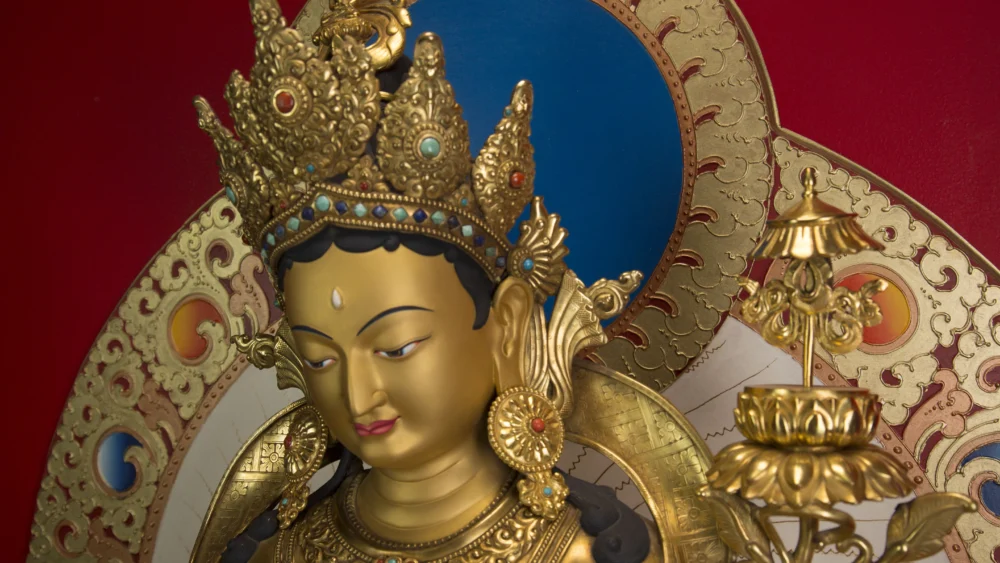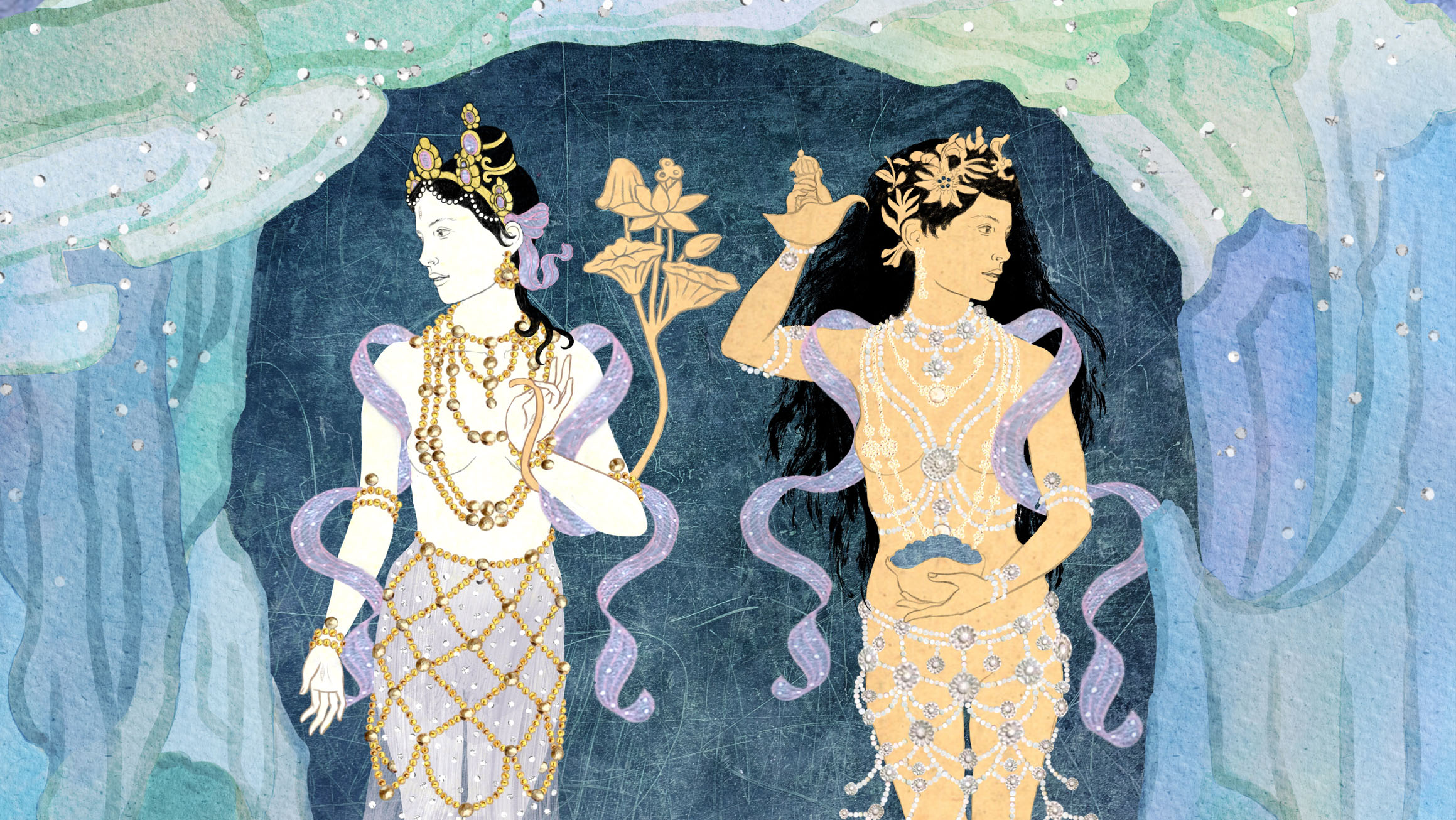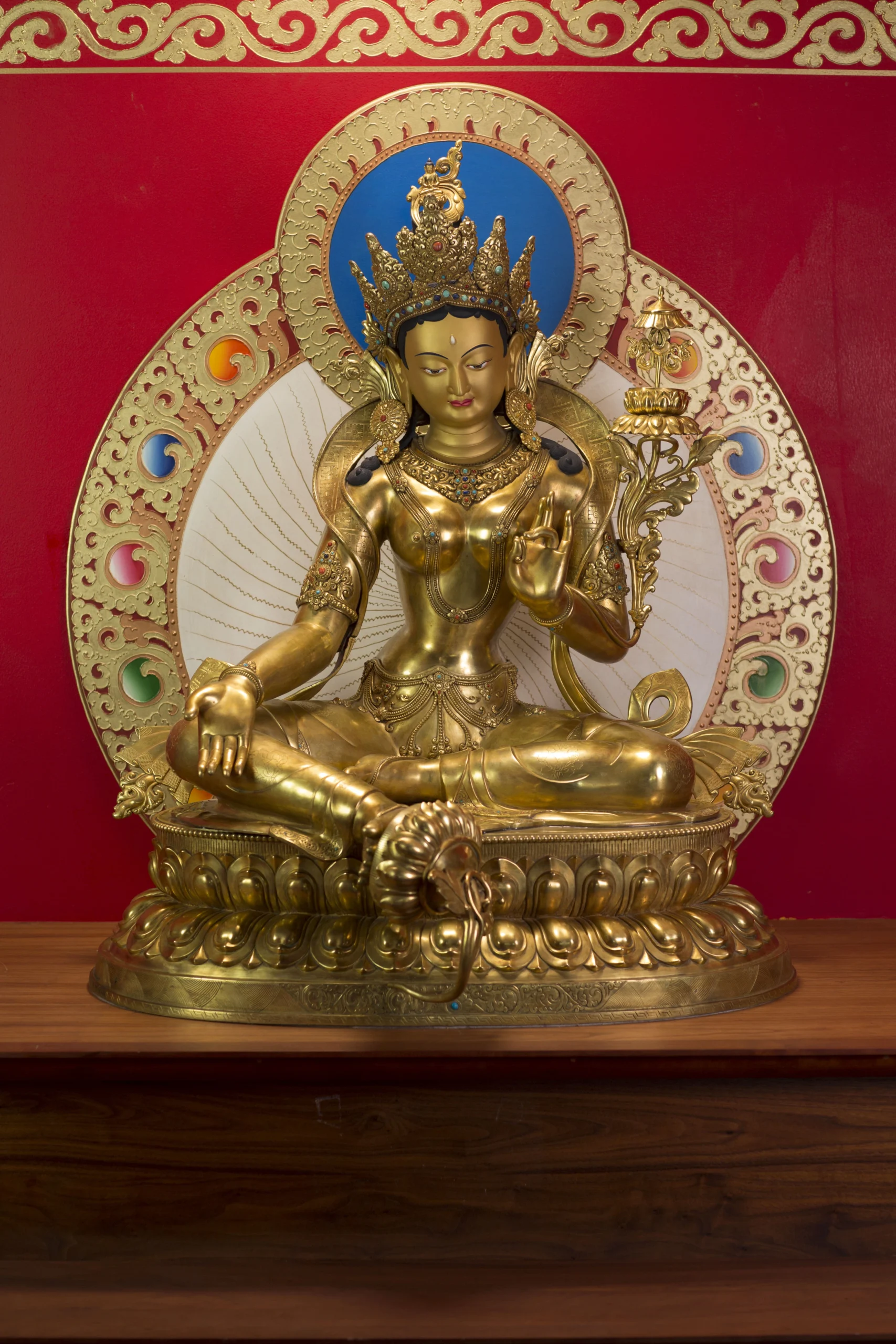
Welcome to Black History Month 2024. February is a time when we can increase our cultural literacy and learn more about the history, the culture and the people of African descent around the world. We are featuring an excerpt from Dorje Lopön Chandra Easton’s new book Embodying Tara, by focusing on the 19th manifestation of Tara. Following the example of the embodied Tara that Dorje Lopön Chandra identifies, we can see how the expression of the 19th Tara – Drölma Mipham Gyalmo Dugkarmo helps us to confront racism and the practice of ‘Othering’ which cause so much suffering in the world.
Tara teaches us to manifest compassion for ourselves and for others. She encourages us to fearlessly stand up to the bully of institutional racism and empower ourselves to speak truth to power. She supports our expression of loving kindness toward the goal of true equity in our governments, social structures, organizations, and communities. She helps us liberate our own old habits, misconceptions, and
stereotypical beliefs that continue to keep us separated from one another. She provides the courage for us to recognize the dignity of beings and transform the biases that serve the few at the expense of many. I invite you to each day this month learn something new about people of African descent. As we go through this month collecting stories and information about People of African Descent around the world, celebrate with us the successes, contributions, and beauty that exist with the African Diaspora.
Let’s all shift our mindset to envision a world where diversity is embraced, inclusion is fostered, and equity is the equanimity that we take off our practice cushions into the world.
~ Lopön Karla Jackson-Brewer
From Embodying Tara: Twenty-One Manifestations to Awaken Your Innate Wisdom © 2023 by Chandra Easton. Reprinted in arrangement with Shambhala Publications, Inc. Boulder, CO. www.shambhala.com.
[[pg. 235-243]]
The Nineteenth Tara
Tara, Invincible Queen of the White Parasol
Homage to you, Mother [Tara], honored by sovereigns,
Divine hosts, gods, and kimnaras
With your full armor of joy and dignity,
You dispel strife and bad dreams.
Tara Sitatapatra is crystal white with a peaceful disposition. Her sublime and regal qualities pacify nightmares, supernatural dangers, misfortune, and religious and mundane conflict and strife. She blesses beings with protective armor—filling us with joy and bliss; making our three doors of body, speech, and mind blaze with radiance; and clearing away everything that disrupts our peace of mind. With her metaphoric and majestic armor of joy, she protects the Dharma and those who teach it from disputes and disharmony, so that the Dharma may flourish and continue to benefit beings.
In Sanskrit, sita means “white” and atapatra means a large “parasol” or “umbrella,” thus “Tara of the White Parasol.” In Tibetan, mipham means “invincible,” dug (sounds like duke) “parasol,” and kar “white,” while mo signifies the female gender. She is also known as the “invincible queen”—Tara Ajitarajni in Sanskrit, Drölma Mipham Gyalmo in Tibetan. The Sanskrit and Tibetan are essentially the same: ajita (Tib. mipham) and rajni (Tib. gyalmo) mean “queen.” At times her names are combined as Tara the Invincible Queen of the White Parasol.
Her Mantra
ཨོཾ་ཏཱ་རེ་ཏུཏྟཱ་རེ་ཏུ་རེ་ཧཱུྃ་ཧཱུྃ་ཕཊྲཿཕཊྲཿརཀྵ་རཀྵ་མཾ་སྭཱ་ཧཱ།
oṃ tāre tuttāre ture hūṃ hūṃ phaṭ phaṭ rakṣa rakṣa maṃ svāhā
om tare tuttare ture hung hung phat phat raksha raksha mam svaha
oṃ! Tara! Be swift, Tara! hūṃ! hūṃ! phaṭ! phaṭ! Protection! Protection! maṃ! So be it!
Her Symbol: White Parasol
Upon Tara Sitatapatra’s lotus is a white parasol, a symbol of both protection and royalty in India. In Buddhism, the parasol is one of the eight auspicious symbols representing the Buddha’s spiritual sovereignty, meaning his liberation from the bonds of samsara. The parasol also symbolizes the dome of the sky that casts a protective shadow over the earth, safeguarding beings from harmful elements such as
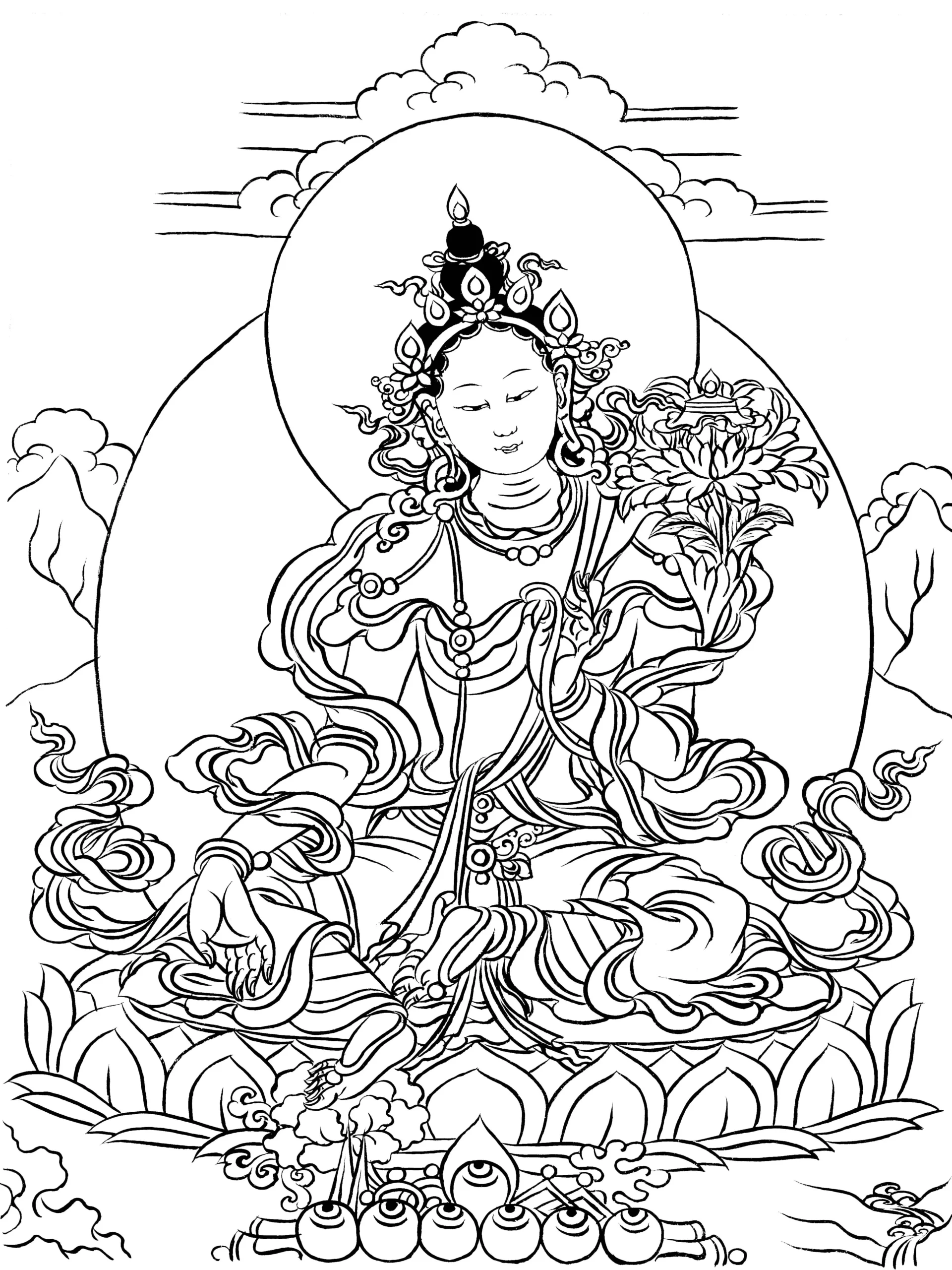
the blazing sun. The parasol handle represents the axis mundi, signifying that whoever is beneath the parasol is the center of the universe. The parasol also indicates the union of wisdom and compassion—the dome as wisdom and the hanging skirt lining the parasol as compassion.
Exploring Tara Sitatapatra’s Facets
Like Vajra Sarasvati, Ushnisha Vijaya, Kurukulla, and Mahabhairava, Sitatapatra is also a goddess apart from this twenty-one-Tara pantheon. Some accounts say that she may have roots as far back as the Jataka tales—the previous life stories of the Buddha—in which she resided in the white parasols of royalty, speaking to them and guiding them in their royal affairs. In the Mahayana text The Noble Dharani of Sitatapatra Sutra, she is called Vajra Ushnisha Sitatapatra, and her origin story is similar to that of the fourth Tara, Ushnisha Vijaya, because they both arose from Buddha Shakyamuni’s crown protuberance (ushnisha). Vajra Ushnisha Sitatapatra did so when he was teaching in the Trayastrimsha heaven, where his mother Maya came to receive teachings from him after she died. At times Sitatapatra is depicted as a terrifying goddess with thousands of heads, eyes, arms, and legs. At other times she is said to be Avalokiteshvara’s counterpart, and like him, she manifests in many elaborate forms such as having many faces, one thousand hands, and one thousand feet.
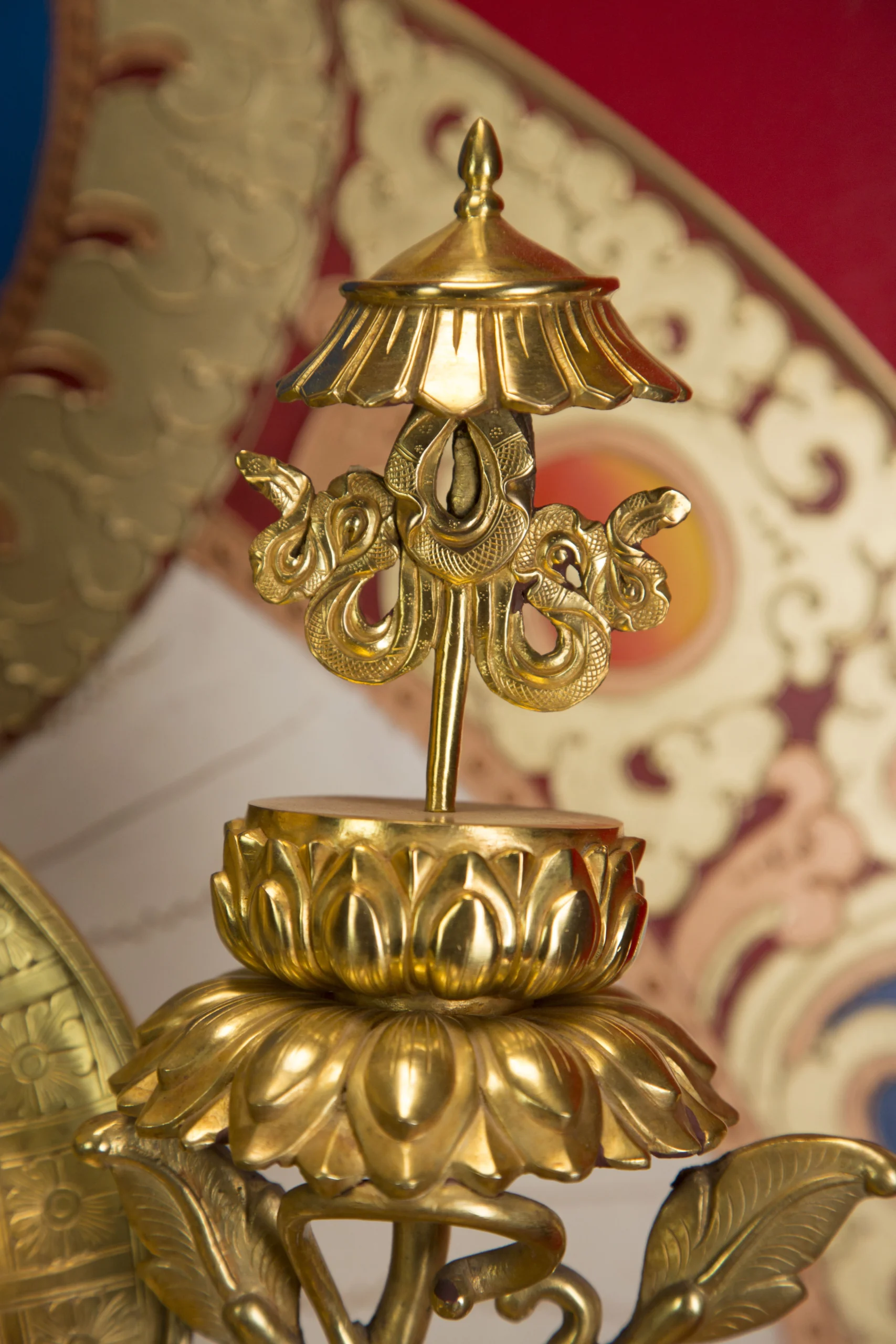
Her Praise
In her praise, Tara Sitatapatra is honored by sovereign and divine beings, namely Indra and Brahma, two important gods associated with the Vedic and Hindu traditions (see “The Twelfth Tara”). Brahma, the creator god, is a personification of the universal principle of brahman, the absolute dimension of reality. The other gods mentioned in the stanza refer to the gods of the mountains, trees, and water who at times bring benefit and at times cause harm. Kimnaras are semidivine beings known for their musical abilities, depicted as half-human and half-horse or half-human and half-bird.
The next two lines of the stanza highlight Tara Sitatapatra’s armor of joy and dignity that protect our well-being and happiness. In this context, her eight sambhogakaya ornaments are seen as majestic armor, each with its own function to help protect beings from strife and conflict and to bestow peace and dignity. She wears her diadem at her crown to
stabilize her bodhichitta; her earrings to prevent slander against spiritual teachers; her shawl, armlets, and anklets to avert the killing of living beings; her necklaces to recollect methods for pacifying concepts; her belt to enact the mudra for binding bodhichitta, and her skirt to cover her lower body. In his commentary to the Praises, Jigme Lingpa states that Tara Sitatapatra emits flaming weapons and vajra sparks to protect beings from strife. So while here she is depicted as peaceful, she can also protect beings with an unparalleled ferocity, hence her epithet Invincible Queen.
As her stanza says, Tara Sitatapatra dispels strife and bad dreams. The Tibetan term for “dispel” is selwa or simply sel. Sel is an important Buddhist term that can mean many things. I’d like to emphasize one aspect of sel, which is to “to illuminate.” Why? Because to heal strife, we must first illuminate it, shine light on it, acknowledge it. Then based upon that illumination, we can begin to heal it, like the clouds clearing. Tara Sitatapatra shines light upon and dispels strife in its many forms.
Breaking the Spell
How might we understand Tara Sitatapatra’s power to dispel negativity, especially supernatural negativity that takes the form of omens, spells, witchcraft, strife, and bad dreams? Today we might benefit from a more secular lens to view spells and witchcraft. Magic and supernatural events are, by definition, beyond science, but isn’t supernatural magic also about perception and deception? I see the smoke and mirrors of broadcast media, social media, corporations, political leaders, and others as another form of trickery—they frequently employ formulas, data, and algorithms to sell their products or personas. The algorithms used by social media companies, for example, feed into our biases and foment polarizing viewpoints as clickbait. Such strategies tend to coerce, hypnotize, and cast spells on people such that we neglect important things like civil liberties and the environment and instead focus on less important things like celebrity drama. Is it not true that manipulating our perception is another way of performing magic, like the sleight of hand in a card trick?
Let’s explore the meaning of joy for a moment since this Tara wears an armor of it. Joy can be understood and experienced in many ways. The American poet Gay Ross explores the facets of joy in his book Inciting Joy, defining it less as the absence of sorrow than as a response to it. In this way, joy has everything to do with our suffering and sorrow; it emerges from it. Joy can be a path to liberation, both personal and collective. Taking a clear-eyed look at injustice, political polarization, and the destruction of the natural world leads us to the necessity of sharing joy amid the sorrow, exploring ways we might resist, and how joy might lead to wild, unpredictable, creative forms of solidarity. Ross posits that it is this solidarity that might just help us survive.
In Buddhism, joy is related to Ross’s definition, but it also goes a step further—it leads us into the blissful abliss. In Dharma, joy bubbles up when we tap into the wellspring of the nature of our own mind through meditation and contemplation. Realizing the nature of our mind is like pouring cold water into boiling water—it instantly neutralizes it and stops it from scalding us. In this way, the experience of our innate joy emerges when we calm the boiling water of suffering and despair. The first stage of realization of a bodhisattva is called the “supremely joyful” because it is an experience of the great peace that comes from realizing the nature of mind itself, free of projections and dualistic clinging. Ross is in line with the Dharma in this respect because joy arises in response to our sorrow. Joy exists because sorrow exists in the same way that light exists because dark exists. Without the contrast of the other, each does not come into being. By meeting our sorrow, we access the wellspring of our joy and the shared humanity that it brings. And yet, when we realize the nature of our mind, we taste that supreme bliss beyond samsara and nirvana.
In our real-life example of Tara Sitatapatra, we’ll explore how such spells and nightmares can be dispelled by celebrating the joy and dignity that come from a collective of liberators working together for the benefit of all. Tara’s protective parasol is not just for VIPs, sovereigns, gods, and holy men; it is for everyone.
Real-Life Embodiment
Black Lives Matter Movement
My choice for the real-life embodiment of Tara Sitatapatra is the movement Black Lives Matter (BLM), which has sought unique ways to hold a protective shield, like Tara Sitatapatra’s parasol, over the lives of those who have been oppressed for too long. Tara’s enlightened activity, as we’ve seen, can manifest as a movement made up of many people working for collective liberation. The BLM mission statement says, “We are a collective of liberators who believe in an inclusive and spacious movement.” A collective of liberators is exactly the kind of movement Tara would be a part of because she is the Liberatrix, and this nineteenth Tara is the Invincible Queen Liberatrix.

Black Lives Matter Founders: Alicia Garza, Patrisse Cullors, and Opal Tometi
BLM was founded in 2013 by Alicia Garza, Patrisse Cullors, and Opal Tometi in response to the acquittal of Trayvon Martin’s murderer. The circumstances of Martin’s death sparked a national debate and protest movement addressing racial profiling in the United States. Now BLM is a global organization seeking to eradicate white supremacy, build local power, and intervene in the violence that is afflicted on Black communities by the government, police, and white supremacists.
White supremacy is an overarching issue that includes notions of toxic masculinity and patriarchy, misogyny, and environmental degradation based on “man over the planet” ways of thinking. White supremacy culture, in which whiteness is elevated above other skin colors, teaches us to center the values of one race as superior to all others. In my opinion, because of its power, implications, and reach across the globe, white supremacy is one of the most destructive negative forces we currently face. Healing the ills of white supremacy is important work because it is liberatory work, and Dharma is all about liberation. The Buddha was a justice guy. He went against the caste system, teaching that all people are equal no matter their gender, race, or social status. He taught to value the Earth and nature, to respect that our actions have consequences, and to treat others with love and compassion. One person’s liberation is tied up in everyone else’s liberation. If others are oppressed, then we are oppressed. This is what is meant by the bodhisattva vow to awaken for the benefit of all beings, because when we really see into the nature of reality, we see that we are all interrelated.
The BLM movement also centers Black joy, imagination, and innovation by highlighting Black artists, writers, musicians, and thinkers, generating means for liberation and collective healing. I see BLM as donning the armor of joy and dignity that Tara Sitatapatra wears as she dispels negative spells such as racism and white supremacy. In a sense, focusing on Black joy and creativity is a way to find refuge under the cool shade of Tara Sitatapatra’s parasol where the collective of liberators can find some rest, safety, and rejuvenation beneath the blazing sun of oppression.
“Black lives matter” does not mean that no one else matters; it means that the Black lives that have historically been excluded and marginalized matter as much as everyone else’s. Of course, all lives matter. The BLM affirms Black, queer, trans, disabled, and undocumented people, as well as women, people with records, and all lives along the gender spectrum. White supremacy is an issue that affects everyone. It is worthwhile to learn about it and support individuals who have been oppressed due to the color of their skin. If you are a white-bodied individual like me, you can use your privileges to help others. To avoid developing a “white savior complex,” let your engagement be well informed and motivated by bodhichitta. As the American author and social activist bell hooks says, the most important way for white people to be of service in the struggle for racial justice is to do their own personal abolitionist work. Through our own journey with this work, we learn how we may knowingly or unknowingly hold white supremacist ways of thinking that cause harm to ourselves and others. We are then able to take steps to dismantle and heal our unperceived biases. It’s rewarding and liberating work; it is Dharma work.
Further Contemplations
Each of us holds multiple identities simultaneously that create different intersecting social locations—gender identity, age, socioeconomic, and so on. If you hold a privileged location in society that affords you opportunities and freedoms based on the way you look, how old you are, etc., then look for places to explore and learn about your own conscious and unconscious participation in systems of oppression. Find skillful ways to transform this participation into a commitment to and solidarity with inclusive communities around you. Have conversations, read, take classes, be humble and curious. And please let go of needing to be perfect. There’s no reason you have to get it right all the time. If you mess up, acknowledge it, apologize, and get up and keep going. Don’t forget to wear the armor of joy and dignity that is Tara Sitatapatra’s reminder to us. Enrich your life by stretching your comfort zone to include friends and experiences to which you may not be accustomed. Find ways to expand your sphere of joy.
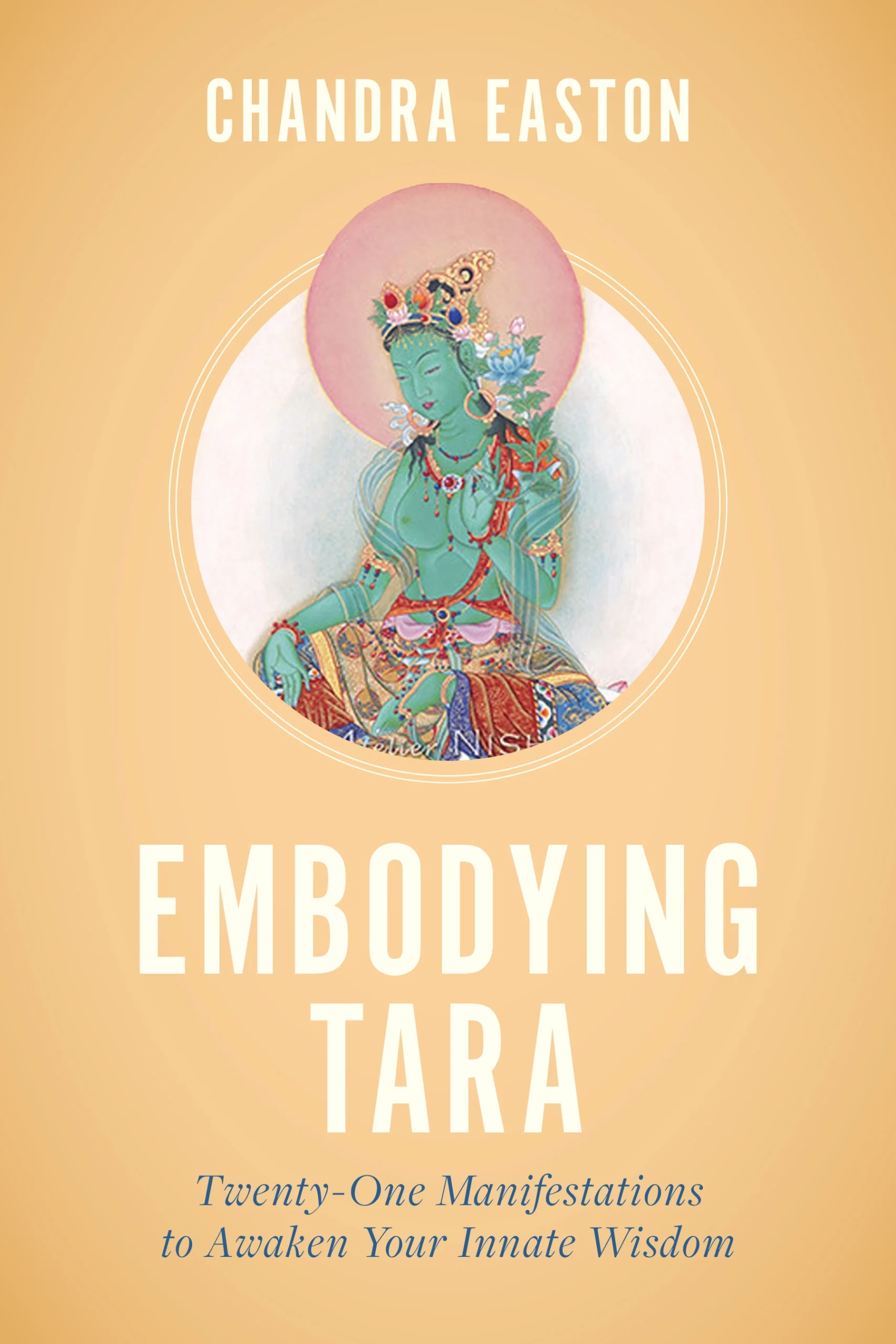
On a more personal level, ask yourself how you might uplift and counteract negative forces, thoughts, and beliefs that cause harm in your life. What does Tara Sitatapatra’s protective parasol and armor of joy feel like to you? How might you create conditions in your life for shade from the blistering sun of negativity? Meditation is one way to become lucid within this waking dream called daily life. How do you find joy—even in the face of adversity? Can you uncover a way to laugh at the preposterous moments? Let humor be your armor of joy.
—-
You can find the meditation on Tara Sitatapatra in Embodying Tara print, e-book and audio versions.

